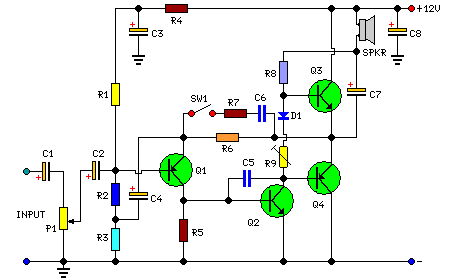Home » Circuits
2Watt Audio Amplifier
Designed for self-powered 8, 4 & 2 Ohm loudspeakers, Bass-boost switchThis amplifier was designed to be self-contained in a small loudspeaker box. It can be feed by Walkman, Mini-Disc, iPod and CD players, computers and similar devices fitted with line or headphone output. Of course, in most cases you will have to make two boxes to obtain stereo.
Circuit Diagram:
Parts:
P1 = 10K
R1 = 33K
R2 = 33K
R3 = 33R
R4 = 15K
R5 = 1K
R6 = 1K
R7 = 680R
R8 = 120R-1/2W
R9 = 100R-1/2W Trimmer Cermet
C1 = 10µF-63V
C2 = 10µF-63V
C3 = 100µF-25V
C4 = 470µF-25V
C5 = 47pF-63V
C7 = 470µF-25V
C6 = 220nF-63V
C8 = 1000µF-25V
D1 = 1N4148
Q1 = BC560C
Q2 = BC337
Q3 = TIP31A
Q4 = TIP32A
SW1 = SPST switch
SPKR = 3-5 Watt Loudspeaker
Circuit Operation:
The circuit was deliberately designed using no ICs and in a rather old-fashioned manner in order to obtain good harmonic distortion behavior and to avoid hard to find components. The amplifier(s) can be conveniently supplied by a 12V wall plug-in adapter. Closing SW1 a bass-boost is provided but, at the same time, volume control must be increased to compensate for power loss at higher frequencies. In use, R9 should be carefully adjusted to provide minimal audible signal cross-over distortion consistent with minimal measured quiescent current consumption; a good compromise is to set the quiescent current at about 10-15 mA. To measure this current, wire a DC current meter temporarily in series with the collector of Q3.

